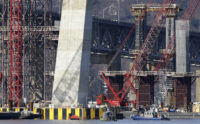The Fluor Corp.-led design-build consortium that constructed the Mario M. Cuomo Bridge across the Hudson River north of New York City is moving into the next phase of its newest lawsuit related to the project costs.
Since the bridge opened to traffic in 2018, the consortium has targeted first the New York State Thruway Authority for payment of extra costs, and more recently, the engineering firm engaged to demolish the key truss of the old Tappan Zee bridge, which it replaced.
In late October a state court judge in White Plains, N.Y., dismissed the first claim against the Authority.
The old structure's demolition trouble provided some unwelcome drama as the bridge team prepared to open to traffic in 2018.
At about the same time, the consortium, Tappan Zee Constructors, filed a new lawsuit in state court. It seeks $45 million from Foothills Bridge Co. for extra costs the consortium claims were incurred when the planned manual demolition of the cantilevered truss, just south of the new bridge, had to be performed with an explosive demolition, significantly delaying work.
Foothills Bridge denies that it is to blame for the problems and countersued for almost $200,000 it says the consortium owes. The company declined to comment beyond its legal filings.
Since the lawsuit began, the legal machinery has ground onward, with depositions of witnesses scheduled for coming months. Attorneys for Tappan Zee Constructors could not immediately be reached for comment on whether attempts had been made to reach a settlement.
According to Tappan Zee Constructors, the consortium hired Boulder, Colo.-based Foothills Bridge to provide engineering for main span demolition, including developing 100% temporary works for use during demolition and an "analysis of demolition stresses and stability for the main span, suspended, cantilever and anchor spans," including stresses and deflections during demolition.
On its website, where Foothills Bridge showcases its work on many big projects across the U.S., the company describes its role on the Tappan Zee bridge as performing engineered dismantling of a 2,400-ft cantilever truss main span. The scope included creating a sequential bridge removal plan, design of temporary truss members, local member stress releases, barge-based crane removal, jacking operations and floating caisson stability.
Popping Sounds and Movement Halted Work
The old structure's demolition trouble provided some unwelcome drama as the bridge team prepared to open to traffic in 2018.
On Sept. 8, just days before the nearly $4-billion replacement bridge was to open, Tappan Zee Constructors announced that there was a flaw in one of the original bridge’s joints. That meant the old structure could fall — although it would be “within a safety zone that does not affect vessel traffic or the structural integrity of the new eastbound bridge,” Consortium President Terry Towle said in a statement at the time.
According to the consortium's lawsuit, as the contractor was removing the east cantilever span sections, popping sounds and bridge movement halted the work. Closer inspection revealed, according to the complaint, that the connection of the bridge's south lower chord had shifted or torn, and that the connection of the chord to the pin had failed causing the chord to separate from the connection.
The reasons, in the consortium's view, is that Foothills Bridge failed to properly consider the capacity of the connections in the structure to resist the forces on them during demolition.
Working with other bridge consultants, the consortium eventually blasted the connections with explosives in January 2019. The amount sought in the lawsuit represents the consortium's increased demolition costs. In its contract, the complaint notes, Foothills Bridge Engineers indemnified the consortium.
In its response to the initial court complaint by Tappan Zee Constructors, Foothills Bridge denied that its errors or actions had caused the problems with demolition and noted that it was engineer of record only for the main span. The problems had been caused by actions over which it had no control, the engineer argued, and Foothills Bridge's work complied with all professional standards.
In its counterclaim against Tappan Zee Constructors, Foothills Bridge says it is owed $183,000 by the consortium for work that it completed on the project.





Post a comment to this article
Report Abusive Comment